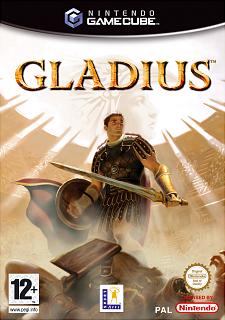Games Database
GameCube
Adventure
| Also for: | PS2, Xbox | ||
| Viewed: | 3D Third-person, floating camera | Genre: | Adventure Strategy: Combat |
| Arcade origin: | No | ||
| Developer: | LucasArts | Soft. Co.: | LucasArts |
| Publishers: | LucasArts
(GB) |
Released: | 28 Nov 2003
(GB) |
| Ratings: | PEGI 12+ | ||
| Accessories: | Memory Card | ||
Summary
One of two gladiator-themed adventures to hit the shelves at a similar time, Gladius takes the more strategical approach of the pair, presenting a turn-based combat game in which players embark on a challenging journey across an assortment of diverse geographical locations, competing in gladiator tournaments.
The story sees you presented with the choice of two heroic characters - Ursula or Valens. Ursula, from the northern land of Nordagh, is the daughter of a great barbarian king, whereas Valens is the son of one of Imperia's greatest gladiators of all time. A bloody conflict between their two homelands gave rise to a vengeful dark god, which nearly destroyed all of mankind. With the help of the revered Valkyrie, and at the great cost of many lives, the dark god was defeated, giving rise to peace between the two lands. Now, darkness threatens again and the two young heroes must fulfill their destinies to keep the world from heading into another disastrous war.
And so the two unite and travel throughout the lands, competing in the tournaments, whereupon they begin to recruit a variety of warriors. After a while they become inadvertently involved in a sinister plot to revive the dark god, at which point the newly-formed band of warriors must take on the quest to solve the mystery of the evil god and defeat those who seek to bring him back.
The game is made up of four main regions - Imperia, Nordagh, the Windward Steppes and the Southern Expanse. Each land has a unique look and feel, and contains a variety of warrior classes that you can recruit and train. As you move from region to region, battles occur in 20 different arenas and more than 12 other locations. Also, on your travels you get to take on random battles and participate in an assortment of side quests.
The actual battles themselves see you apply earned skills and weapons in order to control the power and ferocity of attacks, which are measured by an arcade-style swing meter. Successful fights subsequently earn new skills, awards, fame and fortune, which, themselves, can be bartered for additional teammates, better weapons or advanced training.
Once you have completed your chosen path through the story, the game continues, allowing you to carry on fighting in tournaments, building up your gladiatorial team and exploring the four expansive territories.
The story sees you presented with the choice of two heroic characters - Ursula or Valens. Ursula, from the northern land of Nordagh, is the daughter of a great barbarian king, whereas Valens is the son of one of Imperia's greatest gladiators of all time. A bloody conflict between their two homelands gave rise to a vengeful dark god, which nearly destroyed all of mankind. With the help of the revered Valkyrie, and at the great cost of many lives, the dark god was defeated, giving rise to peace between the two lands. Now, darkness threatens again and the two young heroes must fulfill their destinies to keep the world from heading into another disastrous war.
And so the two unite and travel throughout the lands, competing in the tournaments, whereupon they begin to recruit a variety of warriors. After a while they become inadvertently involved in a sinister plot to revive the dark god, at which point the newly-formed band of warriors must take on the quest to solve the mystery of the evil god and defeat those who seek to bring him back.
The game is made up of four main regions - Imperia, Nordagh, the Windward Steppes and the Southern Expanse. Each land has a unique look and feel, and contains a variety of warrior classes that you can recruit and train. As you move from region to region, battles occur in 20 different arenas and more than 12 other locations. Also, on your travels you get to take on random battles and participate in an assortment of side quests.
The actual battles themselves see you apply earned skills and weapons in order to control the power and ferocity of attacks, which are measured by an arcade-style swing meter. Successful fights subsequently earn new skills, awards, fame and fortune, which, themselves, can be bartered for additional teammates, better weapons or advanced training.
Once you have completed your chosen path through the story, the game continues, allowing you to carry on fighting in tournaments, building up your gladiatorial team and exploring the four expansive territories.












